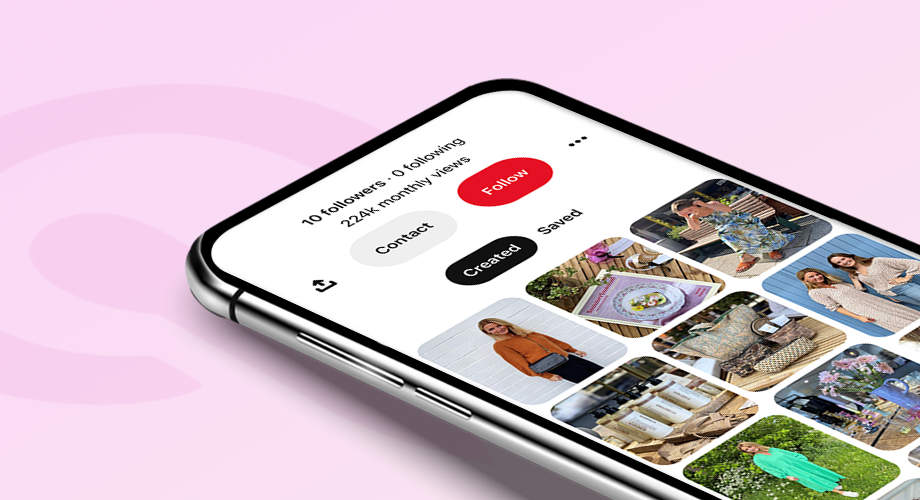
Pinterest is the place where you can get inspiration and ideas for how to decorate your living room, how to best arrange your garden, the latest fashion, DIY’s and much more. However, Pinterest is also the platform for you who own a business and want to sell products, disseminate information, or generally just create more visibility.
Relevant marketing
Pinterest is used to find inspiration for everything between heaven and earth. The advantage of Pinterest is that users are only met with content that is interesting and relevant to them. This is because they themselves set up desired preferences for the posts showing in their feed. And thus, also for the ads.
One of the big advantages of advertising on Pinterest is that you can create marketing without it seeming bothersome to the users. As many as 78% of users find sponsored content useful – if it is relevant. On Pinterest, it is therefore both current but also perfectly okay for ads to appear.
The feed is filled with related posts, and among them the ads blend in. The advertisements therefore appear as ‘wrapped advertising’. They are experienced as organic posts on an equal footing with all the other content that is shared.
Media of influence
On Pinterest, people typically haven’t decided what exactly they’re looking for before accessing the platform. 97% of users are not searching for specific brands but are instead looking for inspiration.
A user looking for pots for the garden might end up buying a particular variety of tomato. Simply because the user has been guided to related posts. Again. And again. As such, the phenomenon is not unique to Pinterest. We also know it, for example, from webshops and streaming services, where we are typically made aware of similar clothes, music, or series, which we might also like. It doesn’t seem like advertising, rather useful. So, thanks for that.
For companies, this means that they can in principle reach out to a potential customer who had no idea that he or she was missing their product or services. By using Pinterest, you can reach a target group that you didn’t know you had, or that you hadn’t reached via the direct route.
Inspiration (for purchase)
Pinterest has great potential for companies trying to sell specific products, as 89% of users are looking for purchase inspiration. If your company sells products related to interior design, gastronomy or lifestyle, the medium will therefore be very suitable for use in your marketing.
However, users also seek out the medium for do-it-yourself projects, where your postings are simply used as inspiration for what they later go out and buy themselves. Here you contribute with value that will benefit your company in the long run. If you leave a good impression on your target audience, the chance that they will remember you will also increase.
Branding for companies
If your company does not have a product that can be marketed visually, you can still use the medium to your advantage. Professions that do not seem obvious at first glance could be, for example, carpenters, painters, or mechanics. If these types of companies are to use the medium, the angle must be rethought.
The strategy for a painter could be to come up with concrete tricks on how to create great results with a particular painting technique. Or as a carpenter you could make a video where you tell or show how to build a dining table from beautiful oak planks. In this way, Pinterest is used to a greater extent for branding rather than sales, as you indirectly inform users about your company.
Who’s on Pinterest?
Maybe you already use Pinterest as a private person. And perhaps you are wondering whether the medium can be a place for companies as well. It is the private users who share or seek posts to be inspired or inspire others, who take up the most space at the platform. But it’s also possible for companies to promote their brand on the platform.
Before you dive headfirst into the project, you should of course consider whether your primary target audience is available on Pinterest. Because no, this is not (typically) where you find the very young target group. Or the older one. On the other hand, there is a broad target group aged 20-40, and women particularly.
Ads on Pinterest
To advertise on Pinterest, you must have a business account. When you create the ad, just like on Facebook and Instagram, you can target it based on your target group, keywords, and interests. You also choose how far you want to achieve traffic, conversions, or views.
Like Instagram, Pinterest is driven by beautiful images. It is therefore also the kind of content that has the greatest potential for success. You should therefore try to make the images extra inviting and inspiring by styling and editing them. Pinterest offers several ad formats that allow you to promote your brand in different ways, but images and videos should be the mainstays.
… But also, be present organically.
If you start to delve into how Pinterest works, you will quickly discover that it all behaves a little differently than on e.g., Facebook. And one of the things you will quickly discover is the potential to also be present organically. That is: without ads.
Users’ feed will not only be filled with profiles they follow and targeted ads. They are actively searching for specific topics, and this is where your business can achieve even greater reach. The more activity you do on your business profile, the more searches you will appear in.
Where the lifespan of a post on Instagram is 48 hours, and on Facebook just 2-5 hours, your company’s post on Pinterest can appear organically for 3-4 months. Your posts therefore abound for a longer period, and more users get the opportunity to discover, interact and share them with each other.